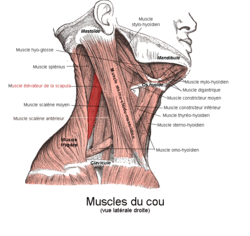Levator scapulae muscle
| Levator scapulae muscle | |
|---|---|

Muscles connecting the upper extremity to the vertebral column. (Levator scapula visible at upper right, at the neck.)
|
|

Muscles of neck. (Levator scapula visible at center left.)
|
|
| Details | |
| Origin | Posterior tubercles of transverse processes of C1 - C4 vertebrae |
| Insertion | Superior part of medial border of scapula |
| Artery | dorsal scapular artery |
| Nerve | cervical nerve (C3, C4) and dorsal scapular nerve (C5) |
| Actions | Elevates scapula and tilts its glenoid cavity inferiorly by rotating scapula |
| Identifiers | |
| Latin | musculus levator scapulae |
| TA | A04.3.01.009 |
| FMA | 32519 |
|
Anatomical terms of muscle
[]
|
|
In human anatomy, the levator scapulae (/ˌlᵻˈveɪtər ˈskæpjᵿliː/) is a skeletal muscle situated at the back and side of the neck. As the Latin name suggests, its main function is to lift the scapula.
The levator scapulae originates from the posterior tubercle of the transverse process of cervical vertebrae one to four. The muscle is inserted into medial border of the scapula extending from superior angle to junction of spine and medial border of scapula
The levator scapulae may lie deep to the sternocleidomastoideus at its origin, deep or adjacent to the splenius capitis at its origin and mid-portion, and deep to the trapezius in its lower portion.
When the spine is fixed, levator scapulae elevates the scapula and rotates its inferior angle medially. It often works in combination with other muscles like the rhomboids and pectoralis minor to rotate down.
Elevating or rotating one shoulder at a time would require muscles to stabilize the cervical spine and keep it immobile so it does not flex or rotate. Elevating both at once with equal amounts of pull on both side of cervical spinal origins would counteract these forces. Downward rotation would be prevented by co-contraction of other muscles that elevate the spine, the upper fibers of the trapezius, which is an upward rotator.
...
Wikipedia
